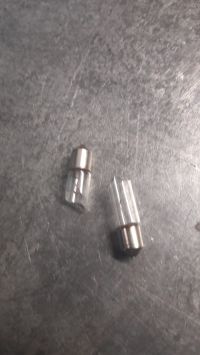FAQ
TL;DR: For a 24 V/3 W tungsten bulb run at 12 V, power drops about 4× because P ∝ V² for a fixed R; “electric power … is proportional to square of voltage.” [Elektroda, krzysiek_krm, post #16856884]
Why it matters: This helps mechanics choose safe 12 V test-lamp replacements without damaging vehicle electronics.
Quick-Facts
- Approx. 12 V power from a 24 V/3 W filament bulb: ~0.75 W (ideal), due to the V² law. [Elektroda, krzysiek_krm, post #16856884]
- Real bulbs are nonlinear; hot filament resistance rises, so measured power can differ from the ideal estimate. [Elektroda, jack63, post #16855695]
- Example measurement: 12.5 V × 0.065 A = ~0.81 W for the 24 V/3 W lamp in a tester. [Elektroda, marekkgb, post #16855577]
- Typical 12 V replacement option: tubular 12 V, 250 mA (~3 W) bulbs are widely available. [Elektroda, Jawi_P, post #16855669]
- 24 V/3 W bulbs are available and inexpensive (about PLN 3 each). [Elektroda, Freddy, post #16856644]
Quick Facts
- Approx. 12 V power from a 24 V/3 W filament bulb: ~0.75 W (ideal), due to the V² law. [Elektroda, krzysiek_krm, post #16856884]
- Real bulbs are nonlinear; hot filament resistance rises, so measured power can differ from the ideal estimate. [Elektroda, jack63, post #16855695]
- Example measurement: 12.5 V × 0.065 A = ~0.81 W for the 24 V/3 W lamp in a tester. [Elektroda, marekkgb, post #16855577]
- Typical 12 V replacement option: tubular 12 V, 250 mA (~3 W) bulbs are widely available. [Elektroda, Jawi_P, post #16855669]
- 24 V/3 W bulbs are available and inexpensive (about PLN 3 each). [Elektroda, Freddy, post #16856644]
How do I estimate a 24 V/3 W bulb’s power when powered at 12 V?
Use the ideal resistor model: P scales with V². Halving voltage from 24 V to 12 V reduces power about 4×, so ~0.75 W. Real tungsten filaments deviate due to temperature, so treat 0.75 W as an estimate, not an exact value. [Elektroda, krzysiek_krm, post #16856884]
Why doesn’t a filament bulb scale linearly with voltage?
Tungsten filament resistance increases sharply as it heats, making the V–I relationship nonlinear. As one expert put it, “Bulbs have a resistance strongly dependent on temperature… this correlation is non-linear.” Expect measured current and power to differ from ideal calculations at lower voltages. [Elektroda, jack63, post #16855695]
My tester shows 12.5 V and 0.065 A. Is ~0.81 W correct?
Yes. Power equals voltage times current. 12.5 V × 0.065 A ≈ 0.81 W, which aligns with expectations for a 24 V/3 W bulb run at about half voltage. A moderator affirmed this calculation approach in the thread. [Elektroda, Adamcyn, post #16856666]
Can lead or clip resistance skew my current reading?
Yes. High resistance in a long lead or alligator clip can reduce current and make the bulb seem weaker. Clean contacts, use short leads, and verify with a low-burden ammeter to avoid under-reporting. This was flagged as a likely cause for low readings in the thread. [Elektroda, Ture11, post #16855635]
What 12 V bulb should I buy to replace a 24 V/3 W in a test lamp?
A practical match is a tubular 12 V, 250 mA (~3 W) bulb. It fits common test-lamp housings and delivers similar brightness at 12 V. If your tester is dual-voltage, verify fit and heat before swapping. [Elektroda, Jawi_P, post #16855669]
Do I need to replace the bulb for 12 V testing if my probe is marked 12/24 V?
Not necessarily. The stock 24 V/3 W bulb will still glow at 12 V, just dimmer, which can be useful for continuity checks without stressing circuits. Many mechanics keep the universal setup intact. [Elektroda, Jawi_P, post #16855669]
Is it safe to probe modern cars with a bulb tester near LIN/CAN wires?
Use caution. A bulb can load or short sensitive data lines (LIN/CAN), risking network faults. Prefer a high-impedance test light or DMM on communication harnesses. The thread warns that a bulb probe can “release LIN/CAN” if you touch the wrong cable. [Elektroda, Anonymous, post #16855639]
Will ~0.2 A from a test bulb close a relay coil?
Yes, many automotive relay coils draw around or below 0.2 A, so a bulb that sources that current can unintentionally energize a relay. Test downstream carefully to avoid unexpected actuation. [Elektroda, marekkgb, post #16855780]
Fast way to estimate bulb power at a different voltage (How-To)
- Measure current at the target voltage with a reliable meter.
- Compute P = U × I for that point.
- Validate by watching brightness and heat; tungsten is nonlinear, so don’t extrapolate far from the measured point. [Elektroda, Adamcyn, post #16856666]
Are 24 V/3 W bulbs rare or expensive?
No. Participants report they are easy to source and inexpensive, about PLN 3 each. Check automotive lighting suppliers or online marketplaces for several form factors. [Elektroda, Freddy, post #16856644]
Do all electrical loads behave like filament bulbs when voltage changes?
No. Behavior depends on component physics and whether voltage is DC or AC. Filaments are temperature-dependent resistors; electronics can be constant-power or constant-current. Start by identifying supply type and load characteristics before extrapolating. [Elektroda, Adamcyn, post #16856865]
Where can I see a bulb’s current–voltage curve to understand nonlinearity?
Review example V–I characteristics for 25 W and 100 W lamps shared in the thread. The plotted curves clearly show rising resistance with current and temperature, explaining dim behavior at reduced voltage. [Elektroda, vodiczka, post #16857090]






